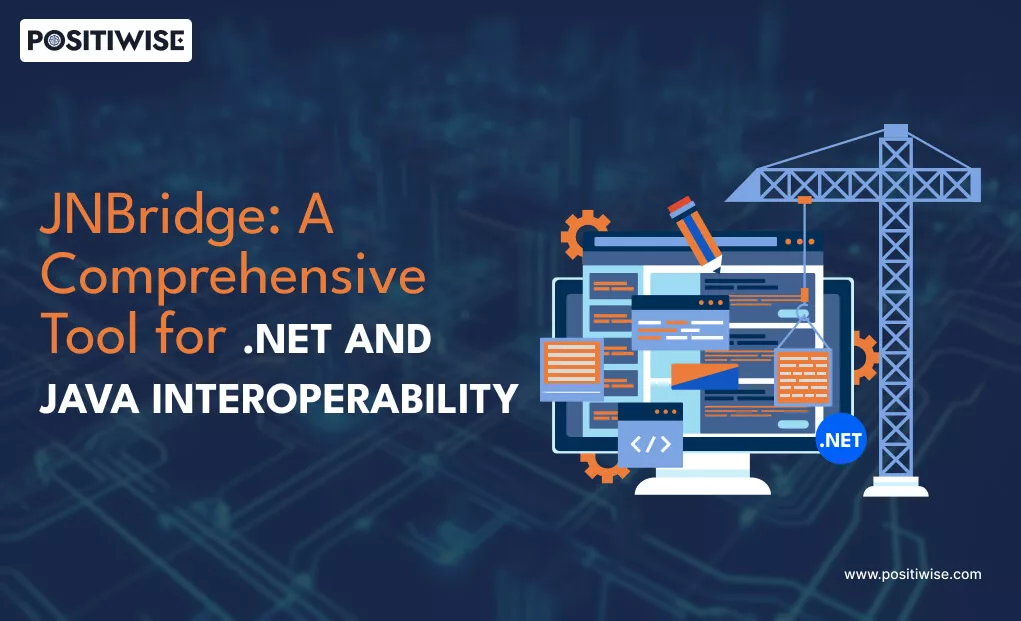Quick Overview:
The JNBridge tool was created to make it easier for Java and .NET framework to communicate with one another. Let us explore below in this blog the features, applications, and variations of the JNBridge tool. We will also explore the benefits it offers that help developers create reliable, cross-platform apps while choosing the best technologies for maximizing performance.
Introduction
A new edition of JNBridge LLC’s Java-to-.Net interoperability tool for programmers was released on Wednesday. .NET Developers creating distributed enterprise applications are the target audience for this product. JNBridgePro adds new capabilities such as pass-by significance, direct mapping across collection classes, assistance with strong naming, enabling Microsoft Corp.’s J# language, thread-true classes that facilitate transactions, and platform performance enhancements. According to JNBridge representatives, the new solution allows Java applications to be standard-compliant while also supporting interoperability between Java and .Net.
What a Bridge is in a Computer Network: Types, Applications, Features, and Variations
In a computer network, the bridge is a networking component that joins several local area networks (LANs) to a single, larger LAN. Numerous networking devices, including hubs, switches, routers, bridges, and others, are used in computer networks. Each device has a distinct function and set of specifications. A networking device called a bridge joins the collection of smaller LAN networks with the bigger LAN networks.
We will cover every aspect of bridges in this article, including their definition and the many kinds found in computer networks. The benefits and drawbacks of the bridge in connectivity will be discussed after examples of these include translational, transparent, and source routing bridges. Next, we will examine the distinctions between the bridge and the gateway. Lastly, we will examine the software programs and functionalities of the bridge inside the network.
Clear Bridges
To connect various network segments and leverage other bridges for routing purposes, translucent bridges are used. All nodes’ MAC addresses and related ports are retrieved via this bridge. Next, inbound frames with recipient MAC addresses on the same port are filtered by the transparent bridge. After that, it uses the associated port to route incoming frames to the target MAC. These bridges are widely used and function transparently for all networks linked to the hosts.
Source: Bridge Routeing
The route between the two hosts is determined by Source Routing Bridges. They employ a frame’s destination MAC address to guide it via the source routing algorithm. On an extended LAN, every station is aware of the route that each frame is delivered over. IBM token rings, and networks employ these. They get knowledge about their bridging knowledge through the data contained in a packet’s structure. Two comparable network segments are linked to the information link layer using this technique. At each point, when end stations connect inside the bridging method, this is accomplished in a dispersed way.
Translational Bridges
To convert one kind of communication system to another, translational bridges are used. They can link several kinds of networks, including Ethernet and ring token networks. When translating between these two frame types, translation bridges rearrange the initial and destination address bits. Depending on the method of transmission, these cables can add or delete data. Various types of network technologies are used to forward the data link layer frame among local area networks.
Benefits of Docker’s Customised JNBridges
One of the greatest networking options for Docker is user-defined bridges, particularly if you want to use it in a production setting. In terms of network definition, they provide more freedom and control. Another strong advantage of the user-defined bridges is container-to-container DNS.
The customized JNBridge network makes it simple for us to accomplish this. To settle an issue in Loki’s realm, we only need to ping Odin by name. The benefit of employing user-defined bridges is that they allow container-to-container DNS resolution. Your programs and services may be more easily orchestrated thanks to this functionality, which makes communication across containers simpler. It’s like allowing your containers to make phone calls to one another by name, which streamlines and improves the overall Docker networking experience.
Container IP addresses frequently shift, particularly when workloads are redistributed. This is no longer an issue with a custom network, as the DNS translates container identifiers to their corresponding IP addresses. This capability is especially helpful in situations where robust and predictable communication between containers is required. You get this feature with the custom network, which is why it’s better than the default bridge network.
Computer Network Bridge
A computer network bridge is a device that joins many local area networks (LANs) into a single, bigger LAN. Bridging is the name of the network aggregation process. The JNBridge, sometimes referred to as a layer of two switches, is a physical or hardware component that functions at the data connection layer of the OSI model. A switch’s principal duty is to inspect incoming traffic and decide whether to forward or filter it. In computer networks, a bridge is essentially used to split the network links into segments; as a result, each segment has its collision domain and throughput. In this case, the bridge is employed to enhance network functionality.
Qualities and Elements of Intelligent Bridges
Sensors/Internet of Things: Several sensors are installed on smart bridges to gather information on environmental elements, traffic patterns, structural health, and other aspects. Real-time data from these sensors is available for observation and decision-making.
Continuous Monitoring: Engineers may access data and receive notifications about any anomalies or possible hazards thanks to smart bridges’ ability to offer continuous remote monitoring. This feature increases safety and speeds up reaction times.
Data Analysis: State-of-the-art analytics methods are employed to examine the data that the sensors have gathered. It helps authorities and engineers understand how the bridge functions, identify any problems and decide on maintenance and repairs with knowledge. Bridges are designed with these qualities to increase overall efficiency, maximize maintenance efforts, increase safety, and prolong bridge lifespans.
An Explanation of Network JNBridge
The functions of a network JNBridge are to link, divide, and filter two different LANs. A network bridge that does this also manages the transmission domain of the sub-LANs it connects. Additionally, by limiting the paths that packets can travel to reach their destinations, network segmentation significantly lowers the frequency of collisions. Network bridges use MAC addresses to forward connections to sub-LANs because they are Layer 2 devices. It annotates the MAC addresses in a specific database on the bridge as it keeps forwarding packets.
The packet is sent to every node via broadcast if the bridge is unaware of the source MAC addresses. The MAC address is marked in the appropriate table upon finding a match.
Similar to how they transmit packets, network gateways filter them. When a network bridge receives a packet from sub-LAN A, it checks the MAC address table. The packet will be filtered if its MAC address is included in sub-LAN A since it won’t be able to reach sub-LAN B.
Although a network bridge and a router have many similarities, they are still quite separate pieces of hardware. These are sophisticated gadgets with additional possibilities for blocking and filtering data transfers. In contrast, a network bridge is a device that only divides traffic using Layer 2 routing. Its main responsibility is to divide a local area network (LAN) into simpler segments to manage for the sake of productivity, safety, simplicity, and organization.
Conclusion
Your services and applications may be more easily orchestrated thanks to this functionality, which makes communication across containers simpler. It’s like allowing your containers to make phone calls to one another by name, which streamlines and improves the overall Docker networking experience. Container IP addresses frequently shift, particularly when workloads are redistributed. This is no longer an issue with a custom network, as the DNS translates container identities to their corresponding IP addresses.
This capability is especially helpful in situations where robust and predictable exchange between containers is required. You get this feature with the custom network, which is why it’s better than the default bridge network.
Expert in Software & Web App Engineering
Parag Mehta, the CEO and Founder of Positiwise Software Pvt Ltd has extensive knowledge of the development niche. He is implementing custom strategies to craft highly-appealing and robust applications for its clients and supporting employees to grow and ace the tasks. He is a consistent learner and always provides the best-in-quality solutions, accelerating productivity.






